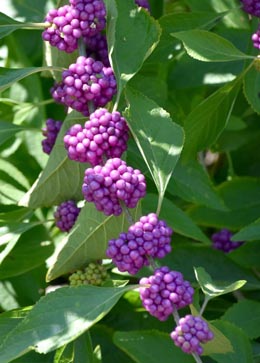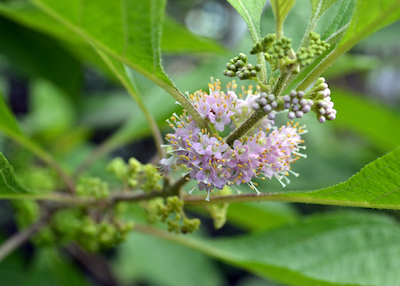Beautiful Beautyberry
A long-lived deciduous shrub that brings striking color to the fall and winter garden
By Gretchen Spencer, former Fairfax Master Gardener

Beautyberry berries
Several years ago, my neighbor and I decided to plant shrubs between the top of our parallel driveways. After researching shrubs that would thrive in that part-sun area of the yard, we decided on Beautyberry (Callicarpa). I knew little about the shrub except that it had stunning clusters of small purple berries that grew atop and around the branches in the late summer and fall. Now, six years later, I can attest to the beauty and grace that this stand of five shrubs, now fully mature, brings to our shared landscape. As I write this in early September, the berries are beginning to turn from pale green to bright shiny purple. And even after the leaves fall off, the berries will continue to adorn the branches into the winter. Wanting to know more about this genus of shrubs, I turned to the experts. In so doing, I tried to determine exactly which species of Callicarpa we had planted, as neither my neighbor nor I had kept a record!
Callicarpa comes from two Greek words (callos meaning beauty and carpos, fruit), referring to the most distinguishing feature of these shrubs. The rounded drupes, composed of approximately 25 to 30 small purple berries that develop from each leaf axil, have been described as iridescent, metallic, and jewel-like. There are about 140 species of Callicarpa worldwide. This genus of shrubs and small trees is in the family Verbenaceae. In the United States, there are four species that are typically planted: one native to the southeastern United States and three non-native Asian species.
Four common varieties
Callicarpa americana, American Beautyberry also known as French mulberry, sourbush, bunchberry, or purple beauty-berry. This native species grows from Southeast Maryland to Arkansas and south to the West Indies and Mexico. According to Michael Dirr in his Encyclopedia of Trees and Shrubs, it is “spectacular in fruit, but coarse in texture.” It grows four to eight feet high and wide in zones 6 to 10. It is often found growing in moist areas of the woods as an understory plant and is the most tolerant of shade.
Callicarpa bodinieri, Bodinier Beautyberry
This species from China has a looser, more open growth habit. It grows six to ten feet high and wide in zones 6 to 8.
Callicarpa dichotoma, purple beautyberry
Dirr rates this species from China and Japan as his favorite because it is the most “refined” and compact of the beautyberries. He praises it for its “graceful, arching, and spreading habit.” This species will thrive in full sun and any well-drained soil. It grows three to six feet high and wide in zones 5 to 8.
Callicarpa japonica, Japanese beautyberry
This shrub grows larger and more open than C. dichotoma, but also has arching branches. It grows four to six (to ten) feet high and wide in zones (5) 6 to 8.
These deciduous shrubs have slender, opposite, elliptical to ovate-shaped light green leaves with saw-toothed edges. Small lavender to pink blossoms appear at each leaf axil in the spring, followed by tight clusters of green berries that turn to bright purple in the fall and winter. Some cultivars have white berries. The stems are slender and develop a lovely weeping effect as they mature, especially under the weight of the maturing berries. After the leaves fall, the berries will remain on the stems into winter.
Calllicarpa can be grown from seed by collecting ripe berries and growing them in pots the first year, before planting them in the garden the following autumn. However, the plants do reseed themselves, and the seed can be spread by animals. I have noticed two “volunteer” plants in my garden.
As noted above, these shrubs are tolerant of a range of growing conditions from partial shade to full-sun. The native North American species are the most tolerant of shade. While Callicarpa should ideally be grown in loose well-drained soil, they will adapt to a range of soil conditions. They also are tolerant of drought though they may drop their leaves and berries in extreme drought conditions. Our plants have fared well in this summer’s heat with the help of our in-ground irrigation system. These plants should be given plenty of room in the landscape, as they do spread out over time. While a single shrub can be planted in a mixed border, massing several plants together creates a cascading effect.
Beautyberries respond well to pruning, as they flower on new growth each spring. The shrubs can be cut back to about six inches in the late winter or early spring, or they can be pruned using a thinning-out method, cutting one third of the oldest canes every year when the plants are dormant. Both methods will control the size and shape of the shrubs. We pruned our shrubs for the first time in the early spring, using the thinning-out method of pruning. The shrubs filled out and are thriving beautifully.

American beautyberry flowers
There are several advantages to growing this shrub, regardless of the variety you choose. It is relatively disease and pest free. It will grow in a variety of conditions from full sun to light shade, and it tolerates a range of soils as well as drought. It is also deer resistant and provides food for wildlife in the winter when food is scarce. The ripe berries are a source of food for many birds, raccoons, opossums, and small rodents. The eye-catching purple berries are a delight in the autumn and winter landscape.
According to the USDA Plant Fact Sheet, Native American tribes used the roots, leaves, and branches of C.americana to treat a variety of illnesses including malaria, rheumatism, dizziness, stomachaches, and dysentery. It was also known as a folk remedy for repelling mosquitoes and other biting insects. Farmers used to crush the leaves and put them under the harnesses on horses and mules as well as rubbing the crushed leaves on themselves to repel insects. It turns out that this folk remedy has a scientific basis. Studies conducted by the Agricultural Research Service found that the leaves contain two compounds, callicarpenal and intermedeol, that repel mosquitoes and other bugs.
I have concluded that the variety of Beautyberry we planted is not C. americana. The native species is reported to be larger than the Asian species and more erect. The leaves are bigger (three to six inches in length), whereas the Asian species have narrower and smaller leaves (one to three inches). The fruit in the American species is wrapped in tightly formed clusters around the branch. The fruit in the Asian species is formed in loose clusters that are more open and grow slightly above the branch. So, now I know that our Beautyberries are definitely non-native. Our best assessment is that we have either C. japonica or C. dichotoma, given that the shrubs are rounded in shape, wide at the top, and have smaller leaves and long, cascading branches covered in small clusters of berries, turning a vibrant purple, that are borne more atop the branches. Regardless of the exact variety, both my neighbors and we love these shrubs for the grace and beauty they provide all year.
References
Dirr’s Encyclopedia of Trees and Shrubs, by Michael A. Dirr, 20ll
American Beautyberry, USDA National Resources Conservation Service, Plant Fact Sheet
Beautyberry, Home and Garden Information Center 1086, Clemson Cooperative Extension
Callicarpa (Beautyberry), Pat Chadwick, Piedmont Master Gardeners, Virginia Cooperative Extension
Beautyberry, The National Gardening Association
… updated 2023